Cite this document
(“FDIC takes the Banks back Research Paper Example | Topics and Well Written Essays - 1500 words”, n.d.)
FDIC takes the Banks back Research Paper Example | Topics and Well Written Essays - 1500 words. Retrieved from https://studentshare.org/miscellaneous/1568968-fdic-takes-the-banks-back
FDIC takes the Banks back Research Paper Example | Topics and Well Written Essays - 1500 words. Retrieved from https://studentshare.org/miscellaneous/1568968-fdic-takes-the-banks-back
(FDIC Takes the Banks Back Research Paper Example | Topics and Well Written Essays - 1500 Words)
FDIC Takes the Banks Back Research Paper Example | Topics and Well Written Essays - 1500 Words. https://studentshare.org/miscellaneous/1568968-fdic-takes-the-banks-back.
FDIC Takes the Banks Back Research Paper Example | Topics and Well Written Essays - 1500 Words. https://studentshare.org/miscellaneous/1568968-fdic-takes-the-banks-back.
“FDIC Takes the Banks Back Research Paper Example | Topics and Well Written Essays - 1500 Words”, n.d. https://studentshare.org/miscellaneous/1568968-fdic-takes-the-banks-back.


